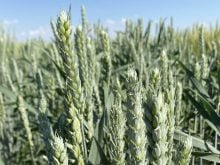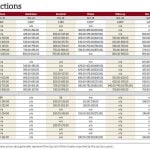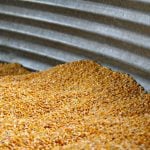Loonie helps fed prices
Stock markets were again volatile last week, but the up days were stronger than the down days and there were indications that efforts by governments to restore confidence were taking hold.
As worries lessened, hope grew that livestock markets would trade more on fundamentals and less on the stock market trend.
In Canada, prices were helped by a weak loonie.
Feedlot producers successfully held out for improved prices over the previous week, Canfax said.
The steer weekly average rose $2.41 to $91.51 per hundredweight while heifers rose $2.09 to $91.
Read Also

Grain farming’s hard times expected to continue
Rabobank says it will be two more years before North American grain farmers achieve break-even due to “monster” supplies and “sticky” crop input prices.
Sales volume dropped one percent to about 18,000 head with a healthy cash offering and larger heifer volume.
The cash to futures basis strengthened to $14.66 under compared to $15.96 under the week before.
Exports to the United States totalled 13,975 head, up 13 percent from the week before but 25 percent lower than last year.
Canfax said that if financial markets stabilize, fed prices could firm as packer inventories dwindle and market-ready supply dips lower.
D1 and D2 cow prices are holding up well under large volumes with cow slaughter year to date up seven percent, Canfax said.
Cows were $35 to $54.75 per cwt. The average was $43.55 for the week, up 36 cents.
Butcher bulls were $40 to $64.25. The average was $54.99, down $2.01 compared to the week before.
Cow and bull exports totalled 3,355 head.
Prices may start to weaken with supplies increasing over the coming weeks, Canfax said.
Beef prices fall
U.S. beef trade reflected the seasonal decrease in demand, Canfax said.
Choice cutouts fell $4.56 to $145.61 US per cwt. and select fell $5.69 to $138.20.
Calgary wholesale markets for delivery this week was steady at $154-$156 Cdn. Montreal was down $2 to $172.
Canadian wholesale demand following Thanksgiving should improve, Canfax said.
Feeder cattle rise
There is much uncertainty in the market with producers delaying taking calves to market because of light buyer interest, said Canfax.
Alberta auction market volume fell 10 percent to 40,894 head, which was 41 percent lower than the same week a year ago.
Steers averaged $1.44 per cwt. higher and heifers were 18 cents lower than the week before, Canfax said.
Feeder cattle exports to the U.S. totalled 11,967 head, which was up from last week at 11,878 and down from 18,807 for the same period a year ago.
If fed prices maintain last week’s gains, feeder prices should also remain steady.
No trade was reported in bred cows and cow-calf pairs.
Hog prices fall
An abundance of hogs and falling pork prices caused U.S. hog prices to fall. Analysts believe the rising U.S. dollar will hurt pork exports.
Iowa-southern Minnesota cash hogs Oct. 17 were $45.50 US per cwt., down from $49 Oct. 10.
The U.S. pork carcass cut-out value fell to $65.02 Oct. 17, down from $68.58 Oct. 10.
U.S. slaughter for the week ending Oct. 18 was estimated at 2.35 million, down from 2.38 million Oct. 11.
The weaker Canadian dollar helped offset the drop in markets.
Bison steady
The Canadian Bison Association said the slaughter market is steady. Grade A carcasses from youthful bulls in the desirable weight range in Canada were mostly $2.30 to $2.50 Cdn, with sales to $2.60 per lb. hot hanging weight. Heifers were $2.25 to $2.40 per lb. with sales to $2.50.
Cull cows and bulls averaged $1 per lb.
Weight, quality and delivery location affect final price.
Lambs steady
There was no sale Oct. 13 at Beaver Hill Auction in Tofield, Alta.
Ontario Stockyards reported 1,265 sheep and lambs and 67 goats traded Oct. 14. Lambs and good sheep were steady. Goats were steady. Thin sheep prices fell.














